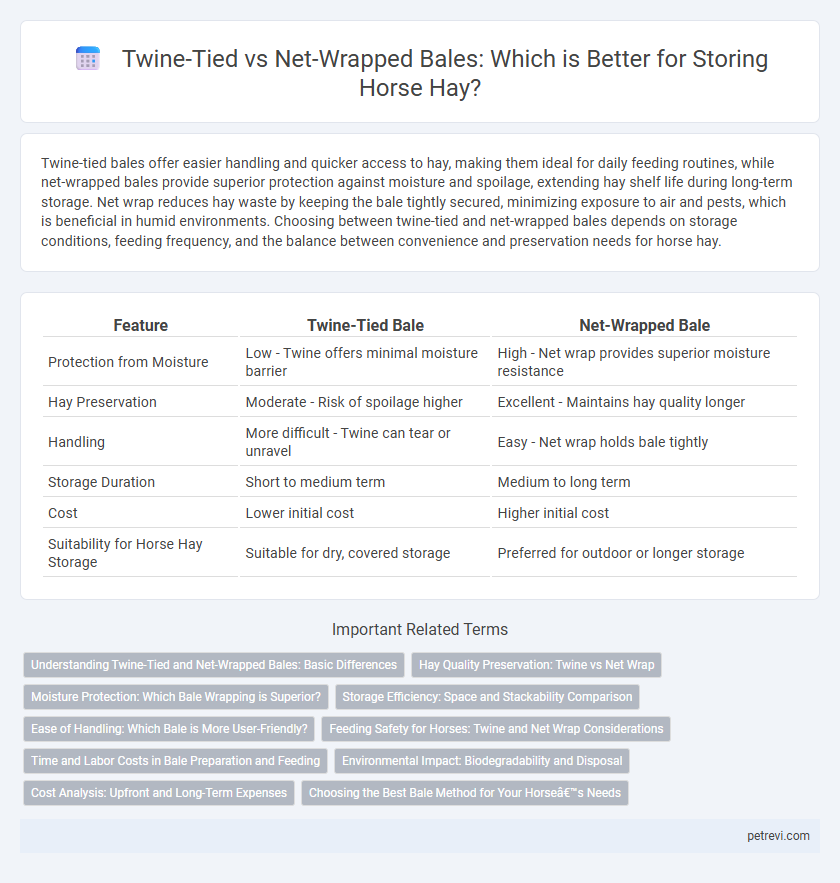Twine-tied bales offer easier handling and quicker access to hay, making them ideal for daily feeding routines, while net-wrapped bales provide superior protection against moisture and spoilage, extending hay shelf life during long-term storage. Net wrap reduces hay waste by keeping the bale tightly secured, minimizing exposure to air and pests, which is beneficial in humid environments. Choosing between twine-tied and net-wrapped bales depends on storage conditions, feeding frequency, and the balance between convenience and preservation needs for horse hay.
Table of Comparison
| Feature | Twine-Tied Bale | Net-Wrapped Bale |
|---|---|---|
| Protection from Moisture | Low - Twine offers minimal moisture barrier | High - Net wrap provides superior moisture resistance |
| Hay Preservation | Moderate - Risk of spoilage higher | Excellent - Maintains hay quality longer |
| Handling | More difficult - Twine can tear or unravel | Easy - Net wrap holds bale tightly |
| Storage Duration | Short to medium term | Medium to long term |
| Cost | Lower initial cost | Higher initial cost |
| Suitability for Horse Hay Storage | Suitable for dry, covered storage | Preferred for outdoor or longer storage |
Understanding Twine-Tied and Net-Wrapped Bales: Basic Differences
Twine-tied bales use traditional string to securely bind hay, offering easier inspection and ply separation but are more prone to moisture penetration and spoilage. Net-wrapped bales feature a durable plastic film that tightly encloses the hay, reducing exposure to weather and preserving nutritional quality during storage. Understanding these differences helps horse owners choose optimal bale protection for maintaining hay freshness and minimizing waste.
Hay Quality Preservation: Twine vs Net Wrap
Twine-tied bales allow for better air circulation, reducing moisture buildup and minimizing mold growth, which helps maintain hay quality over time. Net-wrapped bales provide a tighter seal that protects against rain and dirt but can trap moisture inside, potentially compromising the hay's nutritional value. Choosing between twine and net wrap depends on balancing protection from external elements with airflow to preserve the hay's freshness and prevent spoilage.
Moisture Protection: Which Bale Wrapping is Superior?
Net-wrapped bales offer superior moisture protection compared to twine-tied bales due to their tighter, more durable outer layer that resists water penetration and reduces spoilage. Twine-tied bales allow more air and moisture ingress, increasing the risk of mold and nutrient loss in horse hay storage. Maintaining optimal moisture levels with net wrap helps preserve forage quality and supports equine health effectively.
Storage Efficiency: Space and Stackability Comparison
Net-wrapped bales of horse hay offer superior storage efficiency due to their uniform shape and compact size, allowing for higher stackability and optimized use of available space compared to twine-tied bales. Twine-tied bales often have inconsistent compression, leading to irregular shapes that reduce stack stability and increase the overall storage footprint. Utilizing net wrap minimizes bale deformation, enabling denser stacking and better protection from moisture, ultimately preserving hay quality for longer periods.
Ease of Handling: Which Bale is More User-Friendly?
Twine-tied bales offer straightforward handling due to their traditional design, allowing easy gripping and stacking, but may require repeated tightening to prevent loosening. Net-wrapped bales provide enhanced durability and resistance to weather, making them more user-friendly during transport and outdoor storage while reducing material loss. For horse hay storage, net-wrapped bales generally offer improved ease of handling by minimizing hay spoilage and simplifying bale management.
Feeding Safety for Horses: Twine and Net Wrap Considerations
Twine-tied bales offer secure containment but pose higher risks of horses ingesting loose twine, which can cause digestive blockages or injuries. Net-wrapped bales reduce the likelihood of loose material ingestion, enhancing feeding safety by keeping hay more intact and minimizing waste. Selecting net wrap with UV-resistant properties further protects hay quality and reduces mold growth, promoting healthier feeding conditions.
Time and Labor Costs in Bale Preparation and Feeding
Twine-tied bales require more manual effort for untying and breaking apart, increasing time and labor costs during feeding compared to net-wrapped bales. Net-wrapped bales streamline bale preparation by enabling quicker, cleaner access to hay, reducing labor intensity and feeding time. Efficient feeding with net wrapping improves overall labor productivity in horse hay management.
Environmental Impact: Biodegradability and Disposal
Twine-tied bales offer superior biodegradability, breaking down naturally without leaving harmful residues, reducing landfill waste and environmental pollution. Net-wrapped bales, often made from synthetic materials, pose challenges in disposal as they do not decompose easily and require proper recycling to minimize environmental impact. Choosing twine over synthetic netting supports sustainable hay storage practices by promoting eco-friendly waste management and lowering the carbon footprint associated with horse hay storage.
Cost Analysis: Upfront and Long-Term Expenses
Twine-tied bales generally offer lower upfront costs due to cheaper materials and simpler equipment requirements, while net-wrapped bales often demand a higher initial investment in specialized wrapping machinery. However, net wrapping provides superior bale protection against weather and spoilage, potentially reducing hay waste and long-term replacement expenses for horse owners. Evaluating total cost effectiveness hinges on factors such as local climate, storage conditions, and hay value, with net wrapping frequently delivering better long-term savings despite the greater upfront cost.
Choosing the Best Bale Method for Your Horse’s Needs
Twine-tied bales provide secure, traditional containment ideal for long-term hay storage, while net-wrapped bales offer faster wrapping and reduced hay loss by minimizing leaf shatter, crucial for maintaining nutritional quality. Horses with sensitive digestive systems benefit from net-wrapped bales due to lower dust and mold exposure, enhancing feed safety. Selecting the best bale method depends on storage conditions, hay type, and individual horse dietary requirements to ensure optimal forage preservation and health.
Twine-Tied Bale vs Net-Wrapped Bale for Horse Hay Storage Infographic

 petrevi.com
petrevi.com